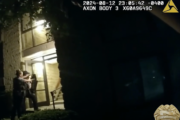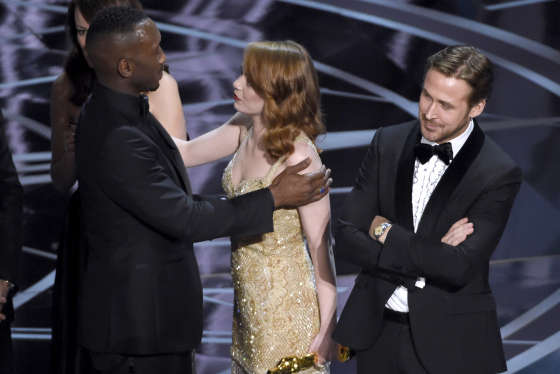WASHINGTON — Call it a lunar eclipse for the city of stars, as “Moonlight” overcame an Oscar envelope gaffe to upset “La La Land” as Best Picture.
After the chaos mercifully subsided, we began to see articles about the historic firsts symbolized by the win. Not only was it the first LGBT-themed film to win Best Picture — thanks to pioneers like “Philadelphia” (1993) and “Brokeback Mountain” (2005) — it was also the first all-black cast to helm a Best Picture winner, while Mahershala Ali became the first Muslim actor to earn an Academy Award.
But landmarks don’t make a Best Picture alone. One reader asked: “Why is the post-victory narrative on ‘Moonlight’ mounted on symbols? LGBQT film, all-black cast film, cheapest film? Are these virtues? Still to come across a piece that talks of merit. Content-wise, what makes ‘Moonlight’ special?”
Time to answer that question, as well as others I’ve received from first-time viewers: What’s with the title? Why does Juan’s character disappear? Am I missing something with the ending? These are vital questions — with clear answers if you look close enough — and now is the perfect time for analysis.
As the second-lowest-grossing movie ever to win Best Picture (behind “The Hurt Locker”), it’s fair to say that very few people in the general public have seen this movie. So, as the low-budget $1.5 million film expands to 1,500 screens as a result of its big win, what exactly makes “Moonlight” so great?
Here’s a scene-by-scene breakdown of the movie’s cinesthetic merits, of which there are many.
Based on Tarell Alvin McCraney’s semi-autobiographical play “In Moonlight Black Boys Look Blue” (2003) — a decade before the lesbian sex scenes in France’s “Blue is the Warmest Color” (2013) — writer/director Barry Jenkins symbolically uses the color blue to craft a sophomore film that is gentle, nuanced and deeply human. It is also brazenly experimental, unfolding as three short films charting different life phases of a young gay black man struggling with his identity in Liberty City, Miami.
Chapter 1: Little
Jenkins opens the film with the sound of crashing waves over the opening credits before delivering a masterful long-take on a Miami street corner. The camera’s circling motion signifies the endless cycle of poverty of the inner-city drug game. It’s here that we meet a charismatic Cuban-American crack dealer, Juan (Mahershala Ali, “House of Cards”), who ponders his moral obligation to his community.
We cut to a frantic handheld shot of a young black boy named Little (Alex Hibbert) running for his life (wearing a blue backpack) from bullies who shout, “Get his gay a**!” He takes refuge in an abandoned row house that recalls the boarded-up vacants in HBO’s “The Wire,” filled with trash and syringes. It’s here that Little is discovered by Juan, who takes the boy under his wing as a sort of father figure.
At the park, we also meet Little’s best friend Kevin (Jaden Piner), who saves him from a game of “smear the qu**r.” Note that Little wears red, while Kevin wears blue, because it’s Kevin who will ultimately introduce him to his true-blue self as the film progresses. Walking through blue-painted hallways at school, Little later walks in on Kevin comparing his genitals to other boys in the bathroom.
The meaning of this “blue” analogy is made clear in a pivotal scene where Juan teaches Little to swim. It begins with water-level shots by Oscar-nominated cinematographer James Laxton, submerging and re-emerging above the surface, set to a transcendent Oscar-nominated score by Nicholas Britell. When Juan and Little return to shore, they sit in the sand to explain the blue moonlight symbolism.
“I was a wild little shorty just like you, running around with no shoes on, the moon was out,” Juan says. “This one time, I ran by this old lady. … She stopped me and she said, ‘Running around. … in moonlight, black boys look blue! You’re blue. That’s what I’m gonna call you, ‘Blue.'” He then adds, “At some point you’ve gotta decide for yourself who you’re gonna be. Can’t let anybody make that decision for you.”
As Juan invites the boy for home-cooked meals by his nurturing wife Teresa (Janelle Monáe, “Hidden Figures”), Little sits silently at the table until finally opening his mouth: “What’s a f**got?” Shocked, Juan says, “A f**got is a word used to make gay people feel bad.” Little’s response is heartbreaking: “Am I a f**got?” Juan says, “No, you could be gay, but you’re not gonna let anybody call you a f**got.” “How do I know?” Little asks. “You just do,” Juan replies. “You’ll know when you know,” Teresa adds.
Turns out, Little learned the F-word from his drug-addict mom Paula (Naomie Harris, “Skyfall”), who’s shown mouthing the slur to him in slow motion. She leaves Little to fend for himself, washing and feeding himself, but despises Juan’s charity, finding it hypocritical that he’s the one selling her drugs. Realizing his own roundabout role in corrupting the boy’s childhood, Juan breaks into tears.
Chapter 2: Chiron
After Chapter 1 cuts to black on an emotional Juan sitting at the dinner table, his character suddenly disappears from Chapter 2. Mainstream viewers might find this odd, but there are clues to his fate if you’re an engaged viewer. You’ll recall that Juan once told Little to never sit with his back to the door, suggesting that Juan got whacked. Chiron’s mom hints at this further saying, “How’s Teresa doing? I ain’t seen her since the funeral.” It’s confirmed by a street bully who says, “Juan been dead a minute.”
With his father figure gone, the adolescent Chiron (Ashton Sanders) sits alone at his high school desk, wearing a blue and yellow shirt while being bullied even harder than before. The class bully Terrell (Patrick Decile) wears symbolic red as he cuts up in class, “Hey yo, that n**** forgot to change his tampon!” Such schoolyard bullying shows that homophobia is rampant among Chiron’s young black peers, possibly fueled by pop-culture notions of street-tough masculinity or old religious traditions.
The bullied Chiron retreats further into himself, staring into a chain-link fence like a cage. It’s teenage Kevin (Jharrel Jarome) who breaks the spell, turning Chiron away from his cage trap. As Kevin brags about having sex “from behind,” Chiron is intrigued. Note the blue behind Kevin and Chiron in this scene — what cinephiles call symbolic mise-en-scène — as Kevin says, “I know you can keep a secret.” We also learn Kevin’s new nickname for Chiron, “See ya, Black.” This name will be important later.
That night, Teresa insists, “It’s all love and all pride in this house,” before Chiron drifts off to sleep. He’s confused by a trippy dream where he exits the yellow light of the back porch and enters the blue moonlight to find Kevin having sex with a girl (symbolically from behind) to the sound of crashing waves. Kevin smiles at Chiron before Chiron snaps awake in bed. Does he have feelings for Kevin?
Sure enough, Chiron later has his first sexual encounter on the beach with Kevin, whose pot-smoking dialogue contains double meanings of foreplay: “I’m about to put you on this blunt!” “It ain’t gonna bite you.” “Trying to put on a show for me, Black?” Soon, the two kiss in the moonlight as Kevin pleasures Chiron with his hand. Jenkins doesn’t have to show everything; less is more. The result is more poetic than graphic, a hand grasping the sand. This same hand is used to shake hands goodbye.
In a perfect world, the two lovers could live happily ever after, but society isn’t perfect. Embarrassed in public, Kevin puts on a front in the cafeteria to stay popular with Terrell, who convinces him to punch Chiron in a game called “knock down, stay down.” After school, Kevin pounds Chiron into a bloody pulp as bullies cheer, “Hit his f**got a**!” Chiron nurses his wounds with a counselor, shouting, “You don’t even know!” The sound fades as Chiron tunes out the adult who doesn’t get his problems.
That night at home, he dunks his face in ice water as the bathroom light flashes in strobe. Tired of being a victim, he returns to school to seek revenge on Terrell, smashing a chair over his back. As Chiron is carried out into police custody, notice the American flag hanging in the background of the classroom, suggesting that society makes criminals out of marginalized folks it refuses to understand.
Chapter 3: Black
Chapter 3 begins with a nightmare as Jenkins repeats the slow-mo shot of Chiron’s mom shouting gay slurs at him, only this time in reverse. Adult Chiron (Trevante Rhodes) snaps awake, dipping his face in ice water like before. Having succumbed to society’s expectations, he now goes by the name Black, is muscle-bound, wears gold grills on his teeth and cruises the street as an Atlanta drug dealer. He’s built himself to look exactly like Juan with a do-rag, diamond earrings and a dashboard crown.
One morning, he’s awakened by a phone call. It’s Adult Kevin (André Holland) apologizing for the teenage clash, informing him that he now works as a chef at a diner and saying he heard a song on the jukebox that reminded him of Chiron. Notice that Kevin stands in a decidedly blue light as he invites Chiron to come meet him, switching his phone into a certain hand to ask, “You do remember me?”
That night, Chiron dreams of Kevin puffing smoke outside the diner, which Jenkins presents in a slow-motion, sensual dream sequence. Upon waking, Chiron is stunned to realized he had a wet dream. He immediately sets off in the car to visit Kevin, but first makes a stop to visit his mom in rehab, as Jenkins places his camera in a high angle in the tree branches, signifying the roots of his family tree.
If you think this mother-son reconciliation is unrealistic after their tumultuous past, remember it was properly set up earlier in the film. Juan said, “I hated my mom, too. I miss her like hell now, though.” Likewise, Chiron’s mom said, “I’m your only.” It seems Adult Chiron takes the advice to heart. As 2Pac sang, “Even though you were a crack fiend mama, you always were a black queen mama.”
After a symbolic shot tilting up from crashing waves to a full blue moon, the moment of truth finally arrives as Chiron arrives at Kevin’s diner. As Chiron sits at the lunch counter, the camera pans between Chiron and Kevin, making the connection to audiences well before the characters notice each other, two “strangers” like Barbara Lewis’ song “Hello Stranger” playing softly on the jukebox.
When the two finally come face to face at the lunch counter, Jenkins employs a daring technique where we hear Kevin’s voice without his lips moving in an intimate close up of his face. Constructed with Oscar-nominated editors Joi McMillon and Nat Sanders, it’s a technique where time stops as the two long-lost lovers reunite in a moment of recognition. A rainbow pattern appears on the fridge behind them as they shake hands with the same hands from their beach encounter. You can cut the sexual tension with a knife as Kevin addresses what they’re both thinking, “Yeah, we’re here, Chiron.”
What follows is a master class of nuance that should be taught in film schools for years to come as an example of saying so much by saying so little. Jenkins weaves together a tapestry of subtle glances, hands preparing food with love, and a wine bottle being intimately poured. Notice how Chiron takes out his gold grills in order to eat, symbolically removing the walls he’s put up. While the red wine, red ketchup bottle and red window curtains match Chiron’s false front as he describes the food by saying, “It’s straight,” Kevin replies, “Man, please,” signaling the blue moonlight shining through the window.
As they head back to Kevin’s apartment, Chiron pauses to watch the crashing waves on the beach in the distance, recalling what Kevin said earlier about the urban ocean breeze: “That breeze feels good as hell, man. … It just comes through the hood and it’s like everything stops for a second.” “It’s like all you can hear is your own heartbeat.” “Yeah, it feels so good, man. That sh*t makes you wanna cry.”
As Chiron admits that Kevin is the only one he’s ever been intimate with, Kevin and Chiron stare at each other on opposite sides of a drawing showing a whale jumping out of water to freedom. The film ends with Chiron putting his head on Kevin’s shoulder, as Jenkins cuts to an image of Young Chiron on the beach staring up at the moonlight, suggesting that Chiron has finally found his true-blue (gay) self.
As you can see, the conflicts in this story provide ample opportunities for directorial symbolism, but what’s the cultural significance? The societal impact is far more profound than you might think.
In one two-hour film, Jenkins offers a less-explored narrative of what it means to be African-American in the 21st century, breaking down old stereotypes and rebuilding new intimate realities. With “Moonlight” now carrying the banner of a breakthrough black film, the cause of gay rights has been firmly intertwined with the civil rights movement, leaving us with one thing: a human story.
If that’s not worthy of Best Picture, I don’t know what it is. You could easily make the case that “Moonlight” is the most important movie of 2016, even if “La La Land” remains the most magical. Which is the better film? It’s so subjective. But can we at least agree that art isn’t a zero-sum game?
Loving “Moonlight” doesn’t mean you must hate “La La Land,” or vice versa. This “choose sides” mentality is the problem. WTOP listeners know full-well my love for Damien Chazelle’s nostalgic musical, an award-season front-runner dinged to death by think pieces levying overblown criticisms:
- Some claimed it must be fascist for casting two white actors in an attempt to save jazz, but if you’ve ever met Damien Chazelle — or seen “Whiplash” — you know his love for jazz runs deep.
- Others claimed it was silly escapism that lacked deeper social relevance, but I contend personal stories are just as important to tell in order to explore human themes of creativity, love and loss.
- Others yet claimed it was a narcissistic tale of self-absorbed dreamers asking, “Are you shining just for me?” But if you look closer, Ryan Gosling crusades to save jazz not for himself but for the world, while Emma Stone sings an anthem for dreamers everywhere, “And that’s why they need us! So bring on the rebels, the ripples from pebbles, the painters and poets and plays.”
On a recent podcast, Jenkins himself said he considers Chazelle a friend and it’s a mistake to put films in political boxes: “I wasn’t on set thinking, ‘I’m going to make a film that can take down the ‘white, fascist musical,’ just like I’m sure Damien wasn’t on set thinking, ‘I’m going to make a movie that can take down the gay, black, hood love story told in an art-house way.’ It just doesn’t work that way.”
He continued regarding the diversity controversy: “Just like all these movies are being framed as a response to #OscarsSoWhite — I think they all arose in a vacuum, and they just arrived at this moment. It’s great for people out there who need a narrative, but we’re just trying to make art.”
Making art is precisely what Jenkins and Chazelle did, creating two incredible movies that pushed the envelope of the film medium and are now forever linked in Oscar history because of an envelope mix-up. One is gritty, one is polished; one is indie, one is star-studded; one earned Best Picture, one earned Best Director; but both are glorious testaments to the unrivaled, eternal power of cinema.






